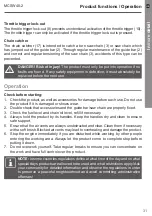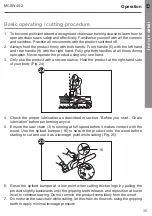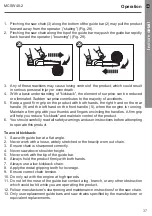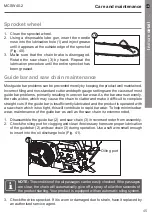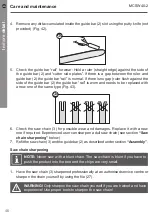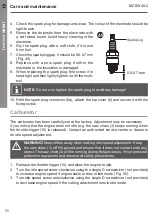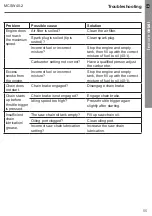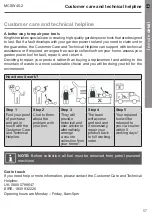
45
MCSW40-2
In
more
detail
. . .
Sprocket wheel
1. Clean the sprocket wheel.
2. Using a disposable lube gun, insert the needle
nose into the lubrication hole (1) and inject grease
until it appears at the outside edge of the sprocket
(Fig. 40).
3. Make sure that the chain brake is disengaged.
Rotate the saw chain (3) by hand. Repeat the
lubrication procedure until the entire sprocket has
been greased.
Guide bar and saw chain maintenance
Most guide bar problems can be prevented merely by keeping the product well maintained.
Incorrect filing and non-standard cutter and depth gauge settings are the causes of most
guide bar problems, primarily resulting in uneven bar wear. As the bar wears unevenly,
the rails widen, which may cause the chain to clatter and make it difficult to complete
straight cuts. If the guide bar is insufficiently lubricated and the product is operated with
a saw chain which is too tight, this will contribute to rapid bar wear. To help minimise bar
wear, maintenance of the guide bar as well as the saw chain is recommended.
1. Disassemble the guide bar (2) and saw chain (3) in reversed order from assembly.
2. Check the oiling port for clogging and clean if necessary to ensure proper lubrication
of the guide bar (2) and saw chain (3) during operation. Use a soft wire small enough
to insert into the oil discharge hole (Fig. 41).
41
Oiling port
NOTE:
The condition of the oil passages can be easily checked. If the passages
are clear, the chain will automatically give off a spray of oil within seconds of
the product starting. Your product is equipped with an automatic oiling system.
3. Check the drive sprocket. If it is worn or damaged due to strain, have it replaced by
an authorised service agent.
Care and maintenance
40

